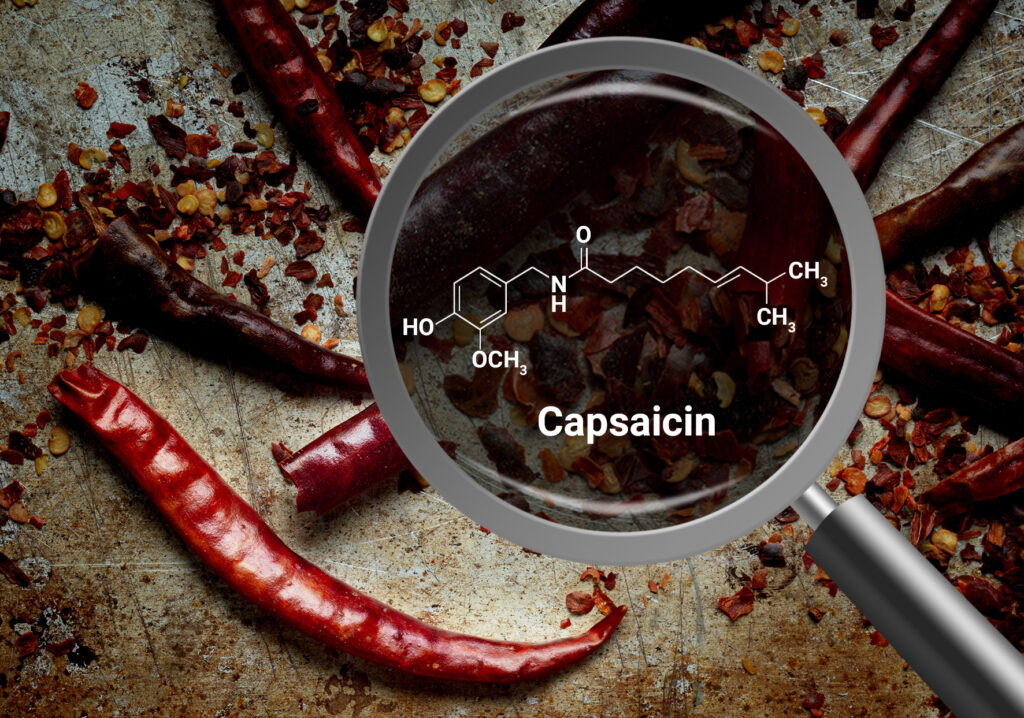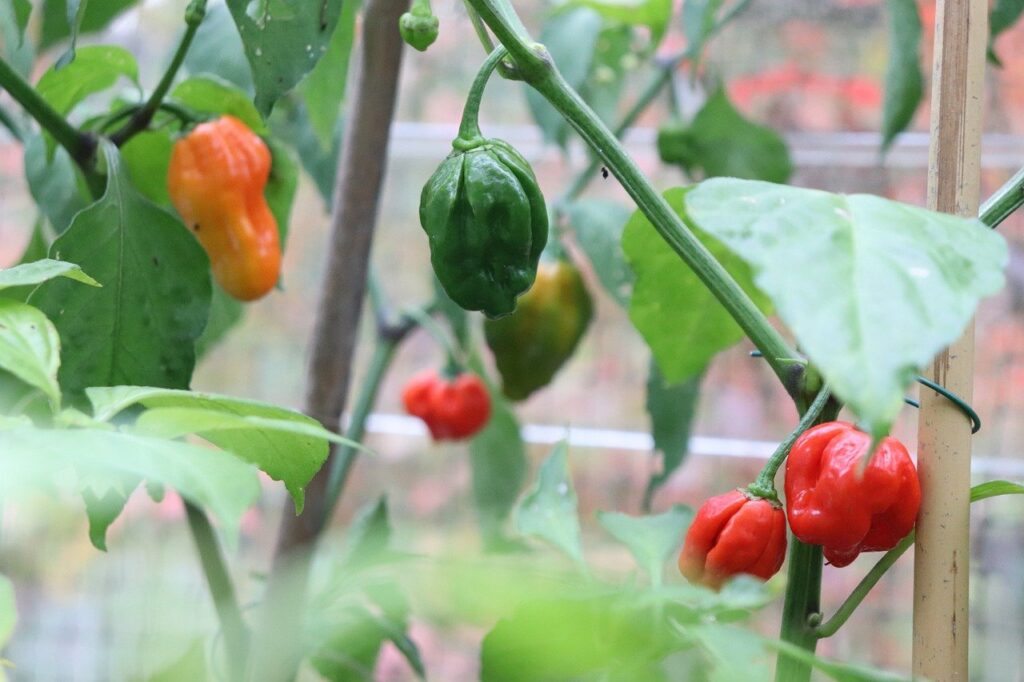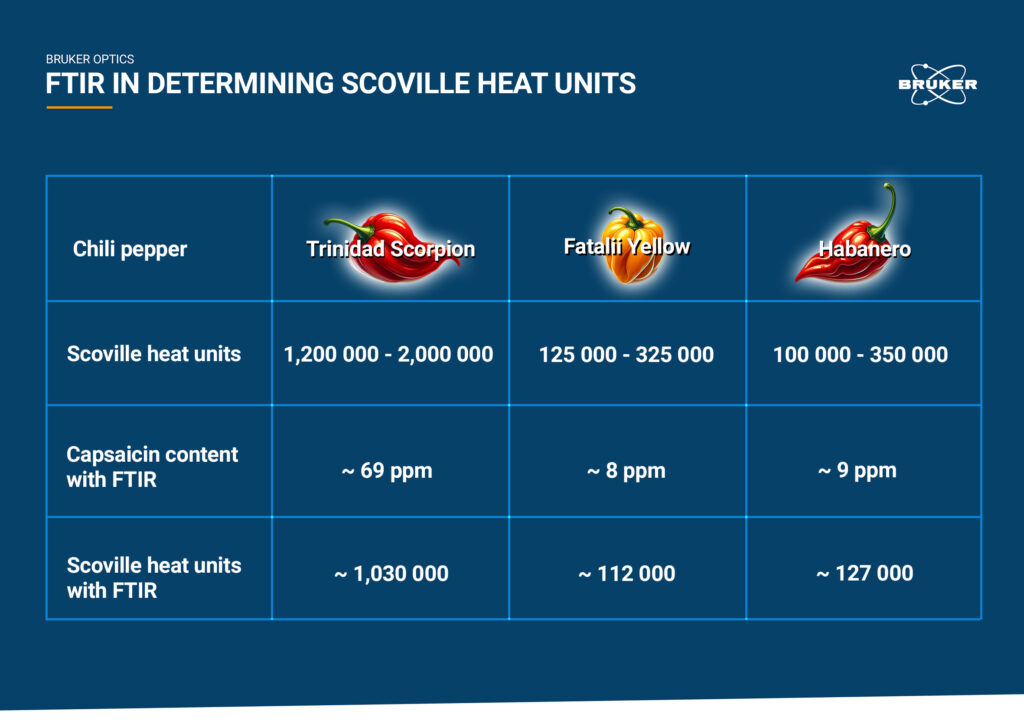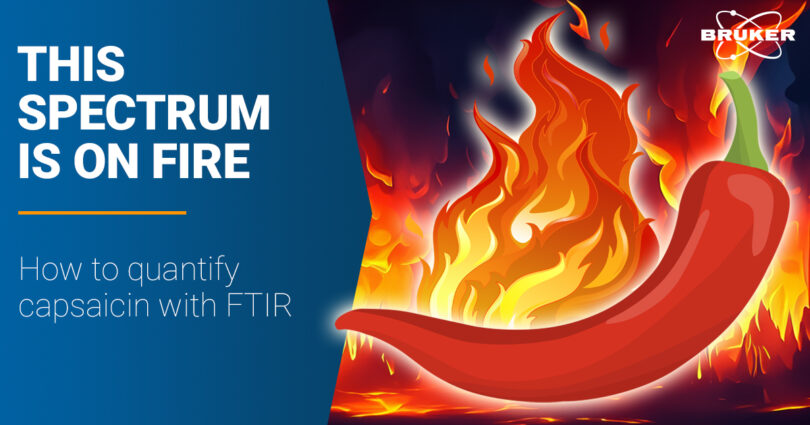The pungency of hot chili peppers is usually given in Scoville heat units which is not particularly objective. A better measure for chili pepper pungency is the amount of capsaicin present in the peppers.
And since there are many spice enthusiasts at Bruker, we asked ourselves: „Is FTIR spectroscopy suitable to scientifically assess the spiciness of chilies?“ – let’s find out together!

Time and again, hot food challenges make negative headlines because participants end up in the emergency room or, even worse, on the cemetery.
Challenges such as the „One Chip Challenge“ often use very potent chili peppers or chili products. These powders or sauces may cause nausea, vomiting or high blood pressure. Such nasty side-effects are caused by the contained alkaloid capsaicin which stimulates specific receptors that create a sensation of heat.
Determining pungency
The pungency of hot foods and spices is typically measured in Scoville heat units (SHU) and depends on the amount of capsaicin present. Traditionally the SHU is determined by a so called organoleptic test through dilution and tasting. Even though this is carried out by trained tasters it is highly subjective.
Why?
Because the perception of heat strongly depends on the personal tolerance to capsaicin which might also increase over time. Therefore, HPLC is now often used as a more objective method for determining the amount of capsaicin.
The disadvantage?
Only laboratories with the appropriate equipment and specialized staff can carry out such an analysis. So, isn’t there something that is easier to use than HPLC and still delivers objective results?
Maybe FTIR could be a game-changer?
As Bruker spice lords still innovate with integrity, we put this question to the test for you with hot chili peppers straight from our colleague’s garden – thanks Sascha!

Hot! Hotter! FTIR!?
Developing a method
But can we just start measuring right off the bat? Unfortunately, no. In order to use FTIR as a quantitative method, we first need to develop a calibration. Here is how we did that.
At first we measured a chili powder sample with a known capsaicin concentration, using Bruker’s ALPHA II FTIR spectrometer. This step is needed to establish a relationship between the concentration of a substance and the measured absorbance values in the spectra.
We then used the acquired spectra and the data available from the chili standard to determine a calibration function for capsaicin. With this we can determine the capsaicin content of any chili we want.
So without missing a beat, we applied this calibration to the chilies that our colleague had grown: Trinidad Scorpions, Fatalii Yellows, and Habaneros. Let’s see what we found out about the pungency of these fellas.
Did it work?
The results are summarized in the char below. With 69 ppm the capsaicin content of the Trinidad Scorpion chili peppers is by far the highest of the three chili varieties. Next came the Habanero with 9 ppm followed closely by the Fatalii Yellow with a capsaicin content of roughly 8 ppm.

To convert these values to SHU we simply need to insert them into the equation below.
SHU = capsaicin concentration (in ppm) x 15,000
As you can see the SHU for the Fatalii Yellow and the Habanero are perfectly within the range reported in literature . The SHU for the Trinidad Scorpion however, show a slightly lower value. This is not surprising since chili’s are a natural product.
The concentration of capsaicin and other chili constituents may vary depending on environmental factors such as soil quality and weather. Dealing with this variability can be tricky.
In our case, the chili was less spicy than expected. However, the opposite can also be true if the chili plant was exposed to external stress factors. This could result in chilies being used in hot food challenges that are potentially much hotter than anticipated, potentially causing harm.
Conclusion
FTIR spectroscopy can effectively be used to quantitatively determine the amount of capsaicin in chilis. While first a calibration has to be carried out, FTIR bridges the gap between lab-grade precision and everyday usability.
Bruker’s ALPHA II and MOBILE IR II FTIR spectrometers are particularly well suited for this purpose as they are easy to use and very robust. They can be used both in the chili production halls as well as in hot food challenges where it must be determined how spicy the used chili peppers really are.
So, whether you’re a chili producer or a hot food challenger, with FTIR spectroscopy, you’re never left guessing – you’ll know exactly how hot your chili is! 🔥
Quantification of material constituents with FTIR is and exciting field. Would you like to know more about it? Then go ahead and read this blog about quantification of silica in coal mine dust:








